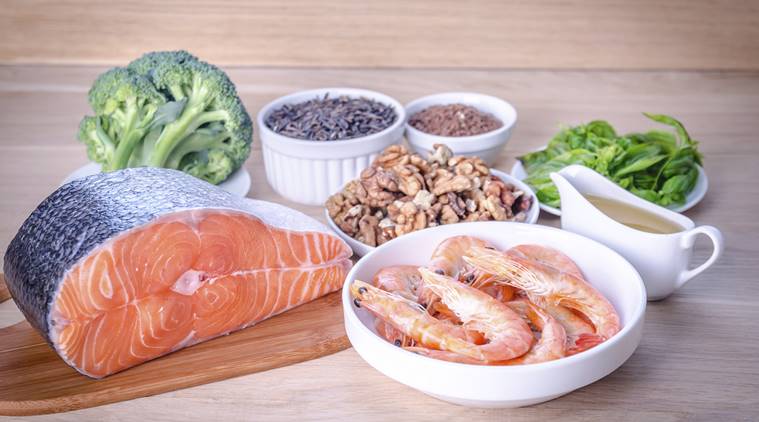During pregnancy, you supply your unborn baby with all the necessary nutrients from the food you eat, and the supplements you take. Omega-3 fatty acids are among the essential nutrients for healthy development of your baby. EPA and DHA are the most important types of omega-3. Because the human body cannot produce omega-3, you have to take omega-3 from food or supplements.

Why Do You Need to Eat Omega-3 Fatty Acids During Pregnancy?
Benefits for the Mother
Omega-3 during pregnancy helps to maintain hormonal balance. This lowers your risk of many health complications in the following ways:
- Reduceing allergic responses and inflammation
- Regulating blood pressure
- Improving and maintaining kidney health
In addition to the above, omega-3 fatty acids improve your mood and help prevent depression. These conditions affect a lot of women during pregnancy. Taking adequate amounts of omega-3 gives you protection against developing some cancers such as breast cancer.
Benefits for the Baby
Taking the recommended amounts of omega-3 throughout the pregnancy helps in the development of the eyes and the brain of your unborn baby. Omega-3 also helps reduce the risk of premature labor. Other benefits to the baby include:
- Supporting healthy birth weight
- Improving production of breast milk
- Supports development of baby’s cognitive functions
Studies also show that babies and children who get adequate omega-3 may get protection from allergies.
What Is Recommended Daily Amount of Omega-3 During Pregnancy?
Because individual needs vary, you need to consult your healthcare professional for assessment. Your nutritionist is best placed to determine the quantity that you require. However, on average, the daily requirement of omega-3 in pregnancy is 300 mg. This is enough to help maintain your health and the development and growth of your baby.
What Are Good Sources of Omega-3?
1. Fish
Fish is rich in omega-3 fatty acids. Following are types of fish grouped according to their omega-3 content:
High Omega-3 Fish (700 mg or more of omega-3 per serving)
- Rainbow trout
- Salmon
- Halibut
- Whitefish
- Canned light tuna
- Pollock
- Atlantic or pickled herring
Moderate Omega-3 Fish (150-699 mg per serving)
- Shrimp
- Catfish
- Canned tuna/white albacore (avoid eating more than one serving per week during pregnancy and breastfeeding)
- Canned blue crabmeat
- Alaskan king crab
- Atlantic cod
- Flounder for sole
What Fish Should I Not Eat During Pregnancy?
Avoid eating the following types of fish during pregnancy:
- Shark
- Marlin
- King mackerel
- Swordfish
- Tuna steaks (fresh or frozen)
- Tilefish (also called golden bass or golden snapper)
- Orange roughy
- Spanish mackerel
- Raw fish
Be Careful with the Toxins
Due to environmental degradation, oceans, lakes and rivers are contaminated with mercury and other contaminants. Most fish contain some amount of mercury. However, certain types of fish contain excessive amounts of mercury. Other fish contain dioxin and PCBs (polychlorinated biphenyls). Ingesting fish with too much mercury or PCBs can affect the growth of your baby’s brain. So you should avoid such fish when you are pregnant.
To get the true picture about fish in your area, contact your local advisories at the local health department or from state agencies online. Note that the overall health benefits of consuming low-mercury fish when you are pregnant or breastfeeding outweigh the risks.
How to Include Fish in Your Diet
Eating fish rich in omega-3 during pregnancy provides your body with the essential fatty acids. It also provides other important nutrients, including protein, vitamin D, iron and zinc.
Broiling, grilling, baking and poaching are some of the healthiest methods of cooking fish. For those who dislike the taste of fish, try flavoring or seasoning it with herbs such as dill, spices such as curry, or cook it with lemon juice. You can also add canned fish into salads or put it in sandwiches.
It is important to cook fish and other sea foods adequately. Eating partially cooked or raw fish or seafood poses the risk of getting diseases such as listeriosis.
2. Non-Aquatic Sources
You can also get omega-3 from non-aquatic sources, including:
- Dark green vegetables
- Walnuts
- Sesame seeds
- Mustard seeds
- Sunflower
- Flaxseed oils
- Canola
- Fortified foods such as eggs, juice and bread
- Soybeans
- Rajmah
- Urad dal
- Lobiya
3. Omega-3 Supplements
The last source of omega-3 during pregnancy is omega-3 supplements. They are in different forms, including liquid, gel and chews. Some of them are flavored to mask the fish flavor. Most omega-3 supplements are made with fish oil. They are mercury-free because the contaminant is not stored in fat tissue.
Some omega-3 supplements are made from sea plants or algae. These do not contain mercury, are free of the fish taste and can be taken by vegans.
When choosing an omega-3 supplement, read the label to confirm that it has been purified to remove contamination with PCBs. You also need to confirm that the supplement contains not less than 200 mg of omega-3. To improve your body’s utilization of omega-3 in pregnancy, cut down on processed and fried foods from your diet.
Note: If you are one of those women who turn to cod liver oil as an omega-3 supplement, read the label carefully and ensure that you don’t exceed the recommended vitamin A dosage. High dose of vitamin A is toxic.
